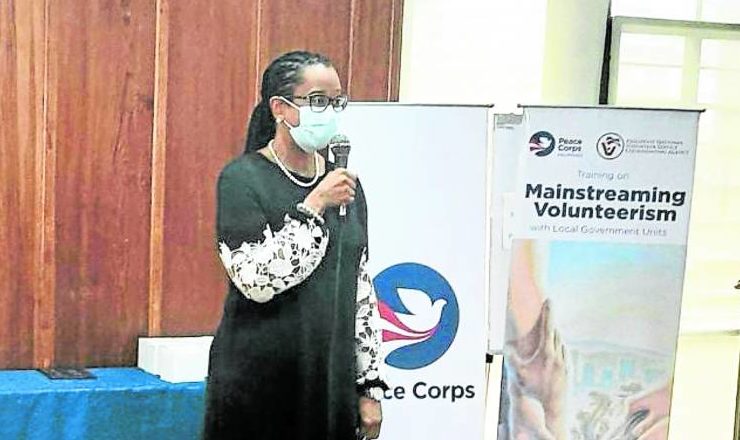US Peace Corps returning to PH

Lyn Cheevers —PHOTO COURTESY OF Carlito Dar
BAGUIO CITY — The US Peace Corps is returning to the country in January next year after it pulled out over a hundred American volunteers in March 2020, shortly before then President Rodrigo Duterte imposed the Luzonwide lockdown at the start of the COVID-19 pandemic.
Dr. Lyn Cheevers, the Peace Corps director for programming and training, said 60 Peace Corps members would be due to fly back to the Philippines at the beginning of 2023.
The Peace Corps pulled out volunteers not just in the Philippines but also in other countries two years ago at the onset of the pandemic, said Cheevers at a briefing here on Wednesday.
Cheevers was in Baguio City to oversee a workshop on the “mainstreaming” of volunteer work in all local governments. The event was organized by the Philippine National Volunteer Service Coordinating Agency, an attached unit of the National Economic and Development Authority.
With COVID-19 restrictions being eased in many states, “our trainees and volunteers have returned to 24 countries around the world,” she said, adding that 48 nations have issued invitations to receive volunteers back.
Article continues after this advertisementThe Peace Corps is an international organization formed in 1960 by the late US President John F. Kennedy. Its members carry out its mission of service by living and working in the developing world, according to the group’s website.
Article continues after this advertisementPrior to the withdrawal in 2020, it had established the largest foreign volunteer presence in the country, according to Roberto Yangco, the Peace Corps youth program manager for the child, youth and family project in the Philippines, who joined Cheevers in the visit here.
Adjustments
But given the changes brought about by the ongoing pandemic, as well as recent disasters like the July 27 Abra earthquake, the incoming batch of volunteers would need to make some adjustments, Yangco said.
“We are in a new normal and we still don’t know what that looks like for the Peace Corps,” he said. “The Peace Corps requires its American volunteers to live with Filipino families. But with the pandemic still around us, we have to learn and adjust. We have to see how they can live with COVID-19 around us.”
There were 120 Peace Corps volunteers in the country before the Luzon lockdown in March 2020.
“It was suddenly all-hands-on-deck,” Yangco said, referring to the pullout that took four to five days to complete. Over a hundred volunteers at the time were sent back to the United States, but they first had to stay at evacuation sites in Manila and Cebu.
“We are still waiting for clearance [about shipping back the Peace Corps volunteers]. We are crossing our fingers that there will no longer be any more [COVID-19] surges … We expect 60 [to return] for the first time in many years,” Yangco said.
Volunteers who undertake the Peace Corps’ regular programs—like teaching or helping build service infrastructure like water pumps in remote villages—normally serve for two years, he added. But there are also “specialists (among them) who serve for six months to a maximum of one year.”
“For our reentry in 2023 … our footprint will not be as large,” said Cheevers.
The Peace Corps wants the incoming volunteers to form small clusters and be assigned in remote areas near health facilities. Because of the health crisis and the country being vulnerable to calamities, she said, the organization would “focus on supporting economic livelihood and recovery from the pandemic.”
Campbell case
Risks have often been part of the Peace Corps’ undertaking.
In April 2007, the remains of Peace Corps volunteer Julia Campbell, who was also a journalist, were found in a shallow grave in Ifugao province after she was reported missing. Campbell was then due to fly home to the United States in two weeks after completing her two-year assignment in the country.
The 40-year-old native of Fairfax, Virginia, was one of the 137 volunteers in the Philippines at the time. She was last seen alive on April 8, 2007, in a hilly area of Barangay Batad, Banaue town. A local wood-carver, Juan Duntugan, was arrested for Campbell’s death and was sentenced to a 40-year jail term for murder in 2008.
Duntugan confessed to killing Campbell but said it was not premeditated. He said he had just fought with his neighbor when Campbell bumped into him, making him drop what he was carrying and, in a fit of anger, he hit her with a rock.
Long-term impact
Many Peace Corps volunteers in the Philippines have been recognized for having a long-term impact on their host communities through the development projects they initiated.
An example is Mary Hensley, who stayed in Kalinga province in the 1970s and worked with local entrepreneur Vicky Garcia to organize Revitalize Indigenous Cordillera Entrepreneurs Inc. Through the venture, locally produced heirloom rice—indigenous varieties planted by generations of Cordillerans—was exported to Montana for the first time in 2005.
In an Inquirer interview in October 2005, Garcia recalled how “Hensley spent a long time in [Kalinga] … looking for a way to help ease … poverty there.”
RELATED STORY